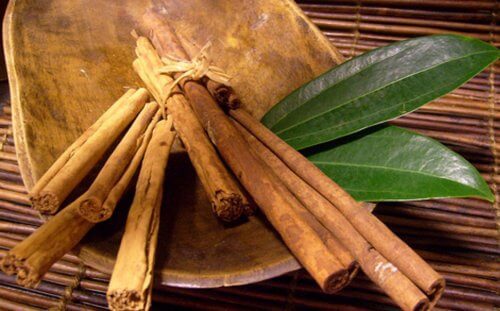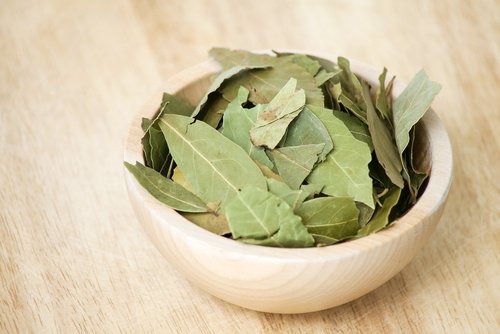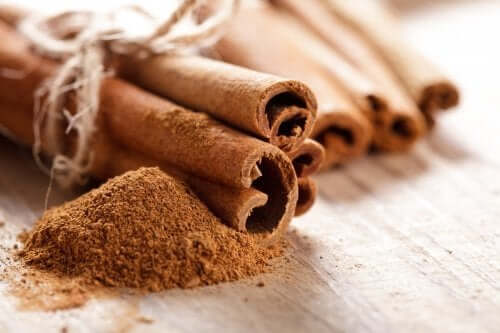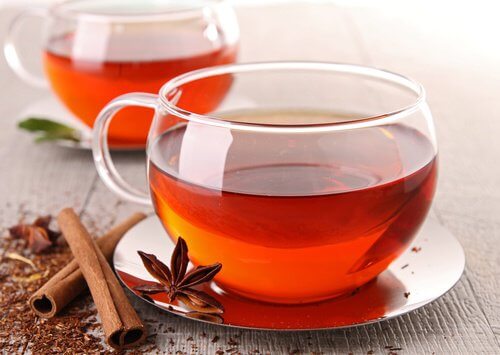Bay Leaf and Cinnamon Tea Can Help You Lose Weight


Written and verified by psychologist Valeria Sabater
Losing weight is often difficult. However, drinking bay leaf and cinnamon tea can prove to be a tremendous help.
It’s not so much a miracle cure but rather an aid to help your body deal better with the stubborn fat that’s often so hard to get rid of.
This is an aromatic, digestive, and also restorative drink. In fact, if you follow a balanced diet and include a cup of this tea just after your meals, you should soon notice great benefits. It’s well worth discovering.
You might also be interested to read: The Incredible Benefits of Bay Leaf Oil
Bay leaf and cinnamon tea: a traditional remedy
Bay leaf and cinnamon tea has been used for many decades to aid weight loss. These two spices are well known for their culinary and aromatic uses, although their properties and possible uses may well go further.
However, it must be said that there’s no scientific evidence to support the use of this remedy to aid weight loss. At the moment, all we know about are the individual properties of the two plants and that the tea has long been used as a traditional remedy.
Bay leaf (laurel)
Laurel is a perennial shrub with multiple functions. It’s extremely common in Mediterranean cuisine. Indeed, since ancient times, the Greeks and Romans have used laurel. They extolled its digestive, expectorant, nutritional, and even healing benefits.
From its Latin root, ‘laurus’ comes the word ‘laureate’ which denotes characteristics of power or virtuosity in front of others.
Laurel is a plant with great importance in natural medicine. Combined with a wonderful spice such as cinnamon, it’s a remedy well worth trying.
Cinnamon
Cinnamon is a tree native to Sri Lanka. Today, it’s also cultivated in India and other areas of South Asia. The part that’s used as a culinary spice is the inner bark. It’s obtained by peeling and rubbing the branches.
Cinnamon is used in preparing infusions and recipes of all kinds all over the world. Both the cinnamon stick and ground powder can be used to prepare sweet and savory dishes.
Essential oils are one of its main components. It also contains acids, terpenes, tannins, and mucilages. Traditionally, the Romans, Egyptians, and the Chinese used it in their traditional medicines to treat respiratory and digestive problems.
Properties of bay leaf and cinnamon
Thanks to the components of both spices, the infusion of cinnamon and bay leaf exerts certain medicinal effects on the body. We explain how including it in your regular diet could be useful.
A digestive remedy

Both cinnamon and bay leaf are characterized by their antiseptic, digestive, restorative, and diuretic actions. Furthermore, a study carried out on 20 medicinal plants confirmed the efficacy of laurel to prevent kidney stones and stomach infections.
Something as simple as having a cup just after meals will help your digestion and prevent you from feeling any discomfort, flatulence, or heartburn.
Bay leaf and cinnamon tea not only provides exceptional flavor but also provides a satiating effect. Therefore, it prevents you from feeling hungry between meals.
Plants with many nutrients

Both laurel and cinnamon contain some interesting nutrients. Some of them can be used in infusions. However, the amounts of each nutrient are rather small and therefore can’t be considered as a main source of the same.
In addition to its purifying, diuretic, satiating, and digestive qualities, bay leaf and cinnamon tea will provide you with the following elements:
- Vitamins A, C, and group B. For example, niacin, riboflavin, pyridoxine, and folic acid.
- Minerals such as calcium, potassium, manganese, magnesium, copper, iron, selenium, and zinc.
It regulates your metabolism
Combining cinnamon and bay leaf is a really helpful way of regulating your metabolism. For instance, bay leaf not only allows you to eliminate toxins, it also reduces uric acid in your body, as well as high blood sugar levels.
Furthermore, both bay leaf and cinnamon improve your circulation and your liver. In turn, they speed up your metabolism so that you can burn fat more easily.
It should be noted that this drink is extremely suitable for diabetics. That’s because some studies show that cinnamon, like bay leaf, could help reduce blood sugar. However, at the moment there are no conclusive results.
Nevertheless, you must bear in mind that you can’t eat bay leaves. Always remember to remove them when you serve your dishes or when you drink the tea.
Also read: 5 Ways of Drinking Cinnamon Tea
How to prepare cinnamon and bay leaf tea

- 1 liter of water.
- 2 cinnamon sticks.
- 5 bay leaves
Method
- Boil the water. Then, add the cinnamon and bay leaves.
- Allow it to infuse for 20 minutes. Let it rest for at least half an hour.
- Strain the contents. You might want to put it in a glass bottle to keep it fresh for later.
- Drink throughout the day. Drink the first cup on an empty stomach and the next after lunch. Start by following this remedy two or three times a week and see how it works for you. Don’t exceed two cups per day.
Possible side effects
Although medicinal plants can have really positive actions on the body, they can sometimes cause side effects. In the case of the bay leaf and cinnamon remedy, it’s better to avoid it in the following cases:
- Pregnancy and lactation. The effects that bay leaf and cinnamon could have beyond food use are unknown.
- Pharmacological treatments. The active principles of plants can interact with certain medicines. Consult with your doctor about taking this drink and how best to introduce it.
- If you’re suffering from any diseases (liver, heart, kidney, etc.) consult with a doctor or a health professional before taking it.
It should also be noted that, although these two spices have positive properties for the body, this drink shouldn’t be taken as a treatment for any of the conditions mentioned or any other disease. It’s a remedy that merely acts in a supplemental manner.
This natural infusion contains two fabulous ingredients for your well-being. However, it shouldn’t be abused.
In fact, excessive consumption of laurel can irritate the walls of the stomach and even cause gastritis. On the other hand, the abuse of cinnamon can cause liver damage. The key, then, is balance.
Finally, you must ensure that the cinnamon you use is of the Ceylon variety. That’s because Cassia cinnamon contains a chemical that could be harmful to your liver after heavy or continued use.
Bay leaf and cinnamon tea may help you lose weight
If you follow a proper diet and exercise, this tea may well help you lose weight more easily. It could be due to some of the individual properties of bay leaf and cinnamon. That said, as we mentioned earlier, there’s no scientific evidence for the effects of this drink on weight control.
You can try taking it as a supplement to an adequate weight loss program but always ensure you respect the recommended doses. Finally, wherever possible, you should seek professional help to lose weight.
All cited sources were thoroughly reviewed by our team to ensure their quality, reliability, currency, and validity. The bibliography of this article was considered reliable and of academic or scientific accuracy.
- Batool S, Khera R. A, et al. Bay leaf. Medicinal Plants of South Asia. 2020: 63-74.
- Bay leaf (herb). (n.d.). britannica.com/EBchecked/topic/56673/bay-leaf
- Biglar M, Sufi H, et al. Screening of 20 Commonly Used Iranian Traditional Medicinal Plants Against Urease. Iranian Journal of Pharmaceutical Research. 2014. 13 (Suppl): 195-198. https://www.ncbi.nlm.nih.gov/pmc/articles/PMC3977070/#__ffn_sectitle
- Fittall, K. Herbs that heal. Good Health. (2014). 80-81
connection.ebscohost.com/c/articles/97507653/herbs-that-heal. - Kawatra P, Rajagopalan R, et al. Cinnamon; mystic powers of a minute ingredient. Pharmacognosy Research. Junio 2015. 7 (Suppl 1): S1-S6.
- Khan, A., Zaman, G., Anderson, R. Bay Leaves Improve Glucose and Lipid Profile of People with Type 2 Diabetes. 2008.
ncbi.nlm.nih.gov/pmc/articles/PMC2613499/ – __abstractid549508title. - Kirkham S, Akilen R, et al. The potential of cinnamon to reduce blood glucose levels in patients with type 2 diabetes and insulin resistance. Diabetes, Obesity and Metabolism. Diciembre 2009. 11 (12): 1100-13. https://www.ncbi.nlm.nih.gov/pubmed/19930003.
- National Center for Complementary and Integrative Medicine. Cinnamon. Mayo 2020.
- Rao P. V, Gn S. H. Cinnamon: A Multifaceted Medicinal Plant. Evidence based Complementary and Alternative Medicine. 2014: 642942. https://www.ncbi.nlm.nih.gov/pmc/articles/PMC4003790/
This text is provided for informational purposes only and does not replace consultation with a professional. If in doubt, consult your specialist.








